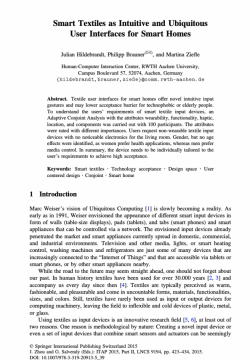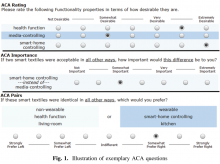
Abstract
Textile user interfaces for smart homes offer novel intuitive input gestures and may lower acceptance barrier for technophobic or elderly people. To understand the users’ requirements of smart textile input devices, an Adaptive Conjoint Analysis with the attributes wearability, functionality, haptic, location, and components was carried out with 100 participants. The attributes were rated with different importances. Users request non-wearable textile input devices with no noticeable electronics for the living room. Gender, but no age effects were identified, as women prefer health applications, whereas men prefer media control. In summary, the device needs to be individually tailored to the user’s requirements to achieve high acceptance.
Hildebrandt, J., Brauner, P., Ziefle, M.: Smart Textiles as Intuitive and Ubiquitous User Interfaces for Smart Homes. In: Zhou, J. and Salvendy, G. (eds.) Human Computer Interaction International - Human Aspects of IT for the Aged Population. pp. 423–434. Springer, Switzerland (2015).
Related Project(s):

